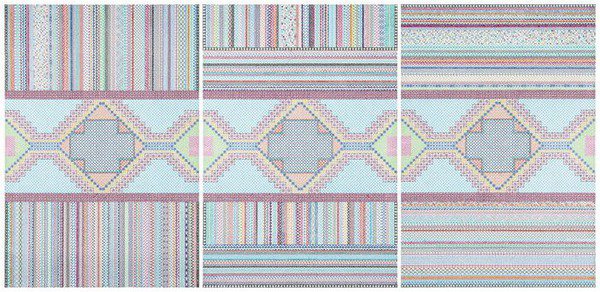Nargess Hashemi
dal 10/1/2014 al 26/2/2014
Segnalato da
10/1/2014
Nargess Hashemi
Gallery Isabelle van den Eynde, Dubai
The Pleasure in Boredom. In this exhibition the artist takes a new direction. Deviating from largely figurative works, she takes the work to its purest and most abstract conclusion.

"Where artistic conventions are grounded in strict discipline and the application of rigid formulas, the practice of art will exclude any relaxation of standards. It is only when these standards are deliberately loosened that artistic practice becomes permeable to that free play of pen we call doodling." E. H Gombrich
In her latest solo show in Dubai, Nargess Hashemi (b. 1979, Tehran) takes a new direction, deviating from largely figurative works centering around themes of domesticity and everyday life and moving in a surprising new trajectory.
The Pleasure in Boredom charts Hashemi's process of developing over ten years worth of experimentation on graph paper. Doodling in notebooks from a young age, during long, tedious car journeys and over extended visits with family and friends, the practice has become somewhat of a lifelong obsession for the artist. Using only the most basic materials, Hashemi adopts a commonly unfocused and subliminal practice and refines it, resulting in vibrant artworks of great complexity.
The title of the exhibition references an essay by E.H. Gombrich, in which the art historian examines the psychology behind the act of doodling and explores its artistic merit. A doodle by its very nature is a subconscious impulse, something that we are naturally compelled to do in a dreamlike, absentminded state. In her new series, Hashemi has evolved this instinctual act into artistic endeavors of great structure and precision.
The Home and Carpet series consist of brightly coloured compositions made up of very simple, repeated, shapes occupying the minute 1mm x 1mm squares on the graph paper. Many of the works in Home depict architectural forms, reminiscent of those in her earlier series. Here, Hashemi eliminates the figures and leaves behind empty rooms and cityscapes devoid of human presence and ultimately takes the work to its purest and most abstract conclusion.
Other works in the series Carpet resemble Oriental carpets with concentric borders containing fields of decorative patterns. Similarly to the weaving tradition that uses the warp and weft technique in the production of handmade Persian carpets, Hashemi considers the lines of the graph paper to serve a similar purpose. In a reference to her earlier work, which centers on domestic scenes, the artist reminds us of the notion that carpets are an extension of the Iranian household, a portable home of sorts. The artist thinks of these works as a metaphorical representation of the essence of 'home' and all of the monotonous repetition, constraint and order that comes with that concept. Unlike the many complexities and restrictions of real life, here, the artist's only constraint is the size of the individual pieces of graph paper. She breaks free of these physical limitations by using multiple sheets and continuing the pattern almost seamlessly, from one page to the next, sometimes using up to 10 sheets for a single work. In theory, the possibilities are endless, leaving room for the viewer to envisage even further development.
As a continuation to this series of works, Hashemi uses the textile knotting technique of macramé, which she learned as a young child. By using the colourful wool as another vehicle to experiment with doodling, she takes the concept in a whimsical direction. Rejecting the standard guidance of a pattern in this instance, the artist allows the shape of the work to develop organically; resulting in unfettered, irregular, amoeba-like forms.
These new works are a progression of her Qajar series, which was inspired by the extravagance and idiosyncratic aesthetic of the royal Qajar court. In these works Hashemi uses the technique of monoprinting to assemble a cast of characters taken directly from the monumental oil paintings of the period. Made up of vivacious dancing girls and the demigod like presence of Fath Ali Shah, she places them onto flattened perspective, cross sectional, architectural backgrounds commonly seen throughout earlier Timurid and Safavid miniatures. By doing this, she symbolically reclaims the long tradition of illustrated poetry manuscripts virtually abandoned during the Qajar dynasty.
The universal practice of subconscious, experimental drawing lends itself to creativity and innovation. By her own admission Hashemi's examinations into this area have not yet reached their zenith and as she continues to explore the endless permutations of this adaptable form she is still finding new and unexpected ways in which to play.
Since her studies, Nargess Hashemi has had several solo shows at Gallery Isabelle van den Eynde in Dubai and in Tehran including at Mah Art Gallery and Aaran Gallery. She has also exhibited in France with Iranian Spring (2004), an exhibition of six artists inspired by the art of Persian miniature painting and poetry selected by the Tehran Museum of Contemporary Art, and in the US, in a touring group show entitled Wishes and Dreams: Iran's New Generation Emerges (2007).
Image: Home, 2013, Pen on graph paper. Triptych, 100 x 70 cm each, 100 x 210 cm overall 1 / 1
For all press inquiries please contact Jules McDevitt at office@ivde.net
Preview January 11, 7–9pm
Gallery Isabelle van den Eynde
Street 8 Alserkal Avenue, Unit 17 Al Quoz 1 Dubai, U.A.E
Hours: Saturday–Thursday 10am–7pm



